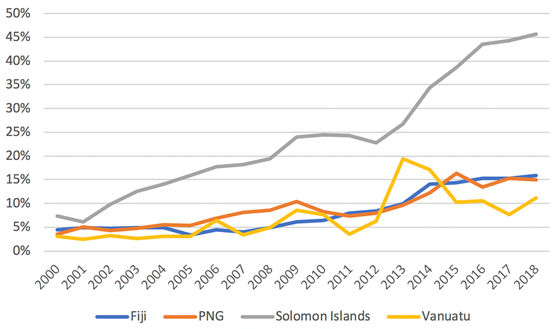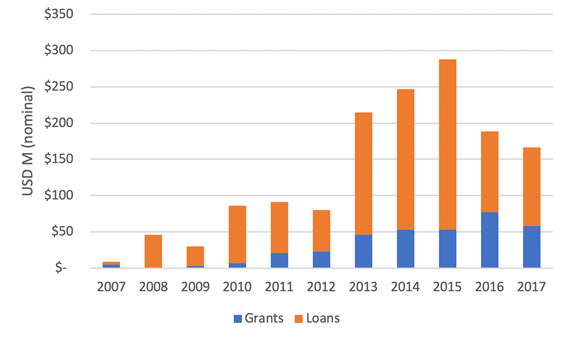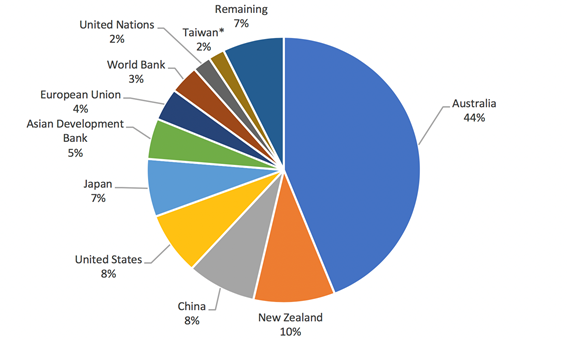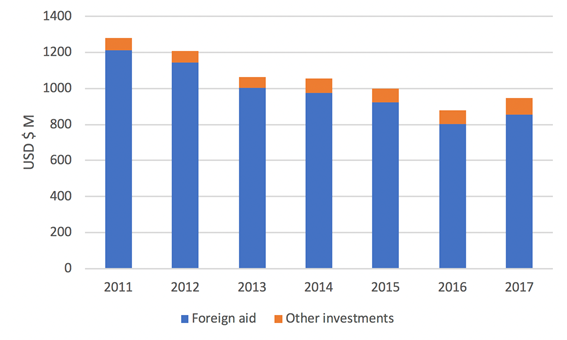Submission to Inquiry into Australia's Defence Relationships with Pacific Island Countries
In July, Jonathan Pryke presented a submission to the Joint Standing Committee on Foreign Affairs, Defence and Trade Inquiry into Australia's defence relationships with Pacific Islands.

Introduction
I welcome the opportunity to make a submission to the Joint Standing Committee on Foreign Affairs, Defence and Trade Defence Sub-Committee’s inquiry into Australia's Defence relationships with Pacific Island nations.
Australia maintains robust and critical defence relationships with all Pacific nations that retain standing militaries. The Defence Cooperation Program, much-valued Pacific Patrol Boat Scheme, as well as work supporting the policing of illegal fishing and transnational crime, links Australia’s defence and security agencies with every Pacific nation.
These institutional links are often the strongest in the region. While these institutional links must be maintained and strengthened, it is critical that the Australian government not look at the Pacific islands purely or predominantly through a strategic lens even as geostrategic competition in the region continues to grow.
Australia can best achieve its security goals in the Pacific by helping the Pacific achieve their own, who view climate change, maritime security, food security and transnational crime as far greater threats to their livelihoods than that posed of China.
Australia aspires to be the partner of choice for the Pacific region. Considering the strength of the existing levels of investment combined with a renewed focus founded on principals of respect, equivalence and friendship I am confident Australia can achieve this ambition in our defence relationship with the region.
Background
Australia’s anxiety of the security and stability of the Pacific Islands region pre-dates the Federation. While this anxiety has changed over time, most acutely felt during the second world war, the importance of the Pacific for Australia’s national security is no less important now than it was 120 years ago. The 2017 Foreign Policy White Paper frames it succinctly:
“Stability in Papua New Guinea, the wider Pacific and Timor–Leste, for example, is vital to our ability to defend Australia’s northern approaches, secure our borders and protect our exclusive economic zone.”
In recognition of the unique strategic importance of the Pacific Islands region, the Australian government has invested significantly in its bilateral and regional security relationships for decades.
Australia rightly takes pride in being the first nation to be called on, and first to respond, in times of crisis in the region. The institutional defence relationships between Australia and the Pacific are amongst the most robust and consistent government-to-government partnerships in the region.
This position as the ‘partner of choice’ to much of the Pacific, especially Melanesia, has largely been untested for the better part of the last 60 years, with the Pacific remaining generally geopolitically benign. In the past three years this status quo has been upended as China’s growing influence has become a more direct and apparent challenge to Australia’s strategic interests in the Pacific.
China's growing presence in the Pacific
China has long had a presence in the Pacific Islands region. Significant pockets of ethnic Chinese have resided in the region for more than a century – the second Prime Minister of Papua New Guinea Julius Chan, and still a member of Parliament, is half ethnic Chinese. Some of the oldest trading houses across the Pacific region originate from China’s Fujian province, similar to many parts of South East Asia and further abroad.
In addition to these historic economic links, the China-Taiwan divide is particularly apparent in the Pacific. As of 2020 four of Taiwan’s remaining 15 diplomatic allies are Pacific Island nations, following the loss of Taiwan’s two largest allies in the region, Solomon Islands and Kiribati, in 2019. This vying for diplomatic alliances has resulted in some degree of political attention and chequebook diplomacy in the Pacific by both China and Taiwan for decades.
Since 2006, however, Chinese activity through trade, aid, diplomacy and commercial activity in the Pacific region has been significantly scaling up.
China is emerging as an increasingly important trading partner. For all Pacific countries, China is a growing export market for the region’s commodities – lumber, raw minerals, oil and gas, and fish. According to the IMF, in 2018 China emerged as a top 3 two-way trading partner for most Pacific nations. If Papua New Guinea is excluded, Pacific exports to China and from China have overtaken those with Australia between 2013 and 2018.

Source: IMF Direction of Trade Statistics.
Chinese engagement has been especially visible in foreign aid. Between 2006 and 2017 China provided close to US $1.5 billion in foreign aid to the Pacific Islands region through a mixture of grants and loans.

Source: Lowy Institute Pacific Aid Map.
In a short time China has become the third largest donor to the Pacific, the most aid dependent region in the world. Australia and New Zealand remain the top two donors, together accounting for 54% of all aid flows to the region in 2017.

Source: Lowy Institute Pacific Aid Map.
Alongside growing aid and trade ties, China has been strengthening its diplomatic links with the Pacific, in particular with the political elite. In the five years between President Xi Jinping’s bilateral visit to Fiji in 2014 and Papua New Guinea (PNG) in 2018 the Pacific took part in more two-way Guest of Government visits (to Beijing or into the region) with China than with Australia. The respect of equivalence built much goodwill for China in the region and was in sharp contrast to the perceived neglect Pacific leaders felt from Australia’s senior politicians.
China solidified its diplomatic links with the Pacific region at the APEC Leaders’ Summit in Port Moresby in 2018. There, President Xi held a special meeting with Pacific leaders who have diplomatic ties with Beijing where they all signed up to Xi’s flagship Belt and Road Initiative. China achieved an even greater victory in September 2019 with the defection of Kiribati and Solomon Islands, Taiwan’s two largest diplomatic allies in the region, in the same week.
But while China has emerged as a formidable player in the Pacific Islands region, it has by no means become dominant. Its engagement, however, stands out from other nations in a number of ways, particularly its foreign aid.
China engages almost exclusively in concessional lending – cheap loans that will eventually be paid back. Three quarters of the finance China has dispersed to the Pacific between 2011 and 2017 has come in the form of loans. These loans, and the types of projects they are financing, have led to calls that China is engaged in ‘debt trap diplomacy’ in the Pacific – using debt as leverage to secure strategic concessions. An extensive assessment of debt dynamics in the Pacific carried out by myself and colleagues at the Lowy Institute concluded that:
“China has not been the primary driver behind rising debt risks in the Pacific, although a continuation of business as usual would risk future debt problems in several countries.”
China also focuses its aid on large infrastructure projects that are exclusively implemented by Chinese State-Owned Enterprises (SOEs) and almost exclusively use Chinese labourers. Such projects are now found in every major capital. These SOEs have now put down deep roots, competing in commercial activity across the board and winning commercially tendered contracts from government tenders and multilateral agencies. According to China’s own investment statistics, Chinese construction activity in the region was $958 million in 2017, almost six times greater than its foreign aid activities. Chinese State-Owned Enterprises have now become the dominant player in construction activity in many countries.
A significant influx of Chinese migrants mirrors growing Chinese commercial activity. Arriving to work on construction sites or fishing vessels, many entrepreneurial Chinese citizens have been enticed by the commercial opportunities that the high-cost and low-competition economies of the Pacific present. While official statistics are limited, anecdotal evidence suggests that no significant town in the Pacific now lacks a trade store being run by a Chinese migrant selling cheap Chinese goods to willing Pacific consumers These entrepreneurs, while motivated by commerce and not directly under the influence of the Chinese state, serve to increase the presence of ‘China’ in the Pacific.
Risks associated with China's rise
So why does all of this matter? You could argue that this is a good thing for the Pacific, a region facing significant development challenges. China gives them options, and in turn greater influence over, and attention from, traditional development partners who have often treated them with a degree of benign neglect. For its part, China insists that it has no specific strategic interests in the Pacific, and that this is just a natural extension of China’s growing engagement in all developing countries.
Unfortunately, there is no depth of scholarly Chinese works on the Pacific Islands region, nor does it factor heavily in official statements, speeches of strategic documents from Beijing. While this may be illustrative on where the Pacific sits in China’s strategic priorities, it also creates a great deal of ambiguity around how China plans to wield its newfound influence in the Pacific region.
Whatever the ambition of China may be in the region, opinions have crystallised for analysts in Canberra and other like-minded countries that China’s growing footprint and influence in the Pacific presents two serious risks to their national interest.
The first risk, which has a low probability of occurring but would have profound impact, is that China is trying to use its leverage – through diplomacy, debt, trade or elite capture – to establish a military base somewhere in the Pacific.
This is a high impact risk because such a development would completely change the way Australia looks at its national defence and security settings. Australia’s armed forces are built to complement and plug in to US-led Coalitions. A Chinese military base as little as 2,000 kilometres from Australia’s eastern coast would force a wedge between Australia and its traditional strategic anchor, the United States. While the strategic benefit and size of such a facility for China is questionable – the logistics of maintaining supply routes alone would be challenging – it would have a profound psychological impact on Australia. It would accelerate a military build-up, confirm all of the most extreme prejudice around China’s strategic intent in the region, and force Australia to ‘go it alone’. Some analysts argue that Australia should be doing this anyway, and the just released 2020 Defence Strategic Update seems to be charting a path in that direction. A Chinese base or outpost of only moderate size would rapidly accelerate this discussion.
There is, however, a low probability this would occur. The main reason for this is that Pacific governments are not simply pawns sitting between Australia and China. They have agency, wield it liberally, and have no interest in a further militarised region. Pacific nations are fiercely protective of their sovereignty. While they may be willing to align themselves with China in certain UN votes, it is a long stretch of the imagination that they would be so willing to hand over a military base or outpost that would so rapidly undermining the sovereignty that they so viscerally protect. The second reason that this is a low probability is that the West is now paying attention. Australia in particular is forcing China to be more than just opportunistic in their ambitions because of the scaling up of its own efforts – both in money and in attention – devoted to the Pacific.
Despite these factors, because of the acute vulnerability and size of these nations, and the potentially large strategic benefits to China for relatively minimal potential investments, this is not a risk to be taking lightly.
The second risk, which is of a lower impact but of a higher probability of occurring, is that China and Chinese businesses, through elite capture and corruption, are undermining institutions of governance which Western donors spend considerable money trying to support. This has become so acute in recent years that one of these nations may be pushed towards a scenario of state failure.
This is a lower impact risk for Australia. The desire for both a stable and prosperous immediate region, combined with Australia’s responsibility as a self-identifying ‘regional leader’, would require Australia to be at the forefront of any intervention to restore stability. This would be a costly exercise, particularly in one of the larger Pacific nations, but it would not fundamentally shift Australia’s security settings. Australia has intervened in the region before, both in Timor-Leste in 1999 and again in Solomon Islands in 2003, and will do so again if called upon.
This risk has a higher probability of occurring, particularly in light of the economic devastation facing the region as a result of COVID-19. While China did not introduce corruption into the Pacific, they are certainly contributing to entrenching systems of corruption and patronage in the Pacific, particularly in Melanesia.
For Australia and other traditional partners in the Pacific the stakes of China’s potential ambitions in the Pacific are significant. China has established itself as an important partner for Pacific Island governments. The opportunity, if it ever truly existed, to keep China out of the region has long passed. Greater and more consistent resolve from the West will be necessary to mitigate these risks.
The Pacific Step-Up
Reflecting Australia’s broad strategic interests in the Pacific Australia is the predominant partner for many Pacific islands in a number of fields. Our aid contributions are by far the largest of any donor. Our diplomatic network now spans across every sovereign nation and many territories. We are a primary trading partner and source of tourism and foreign investment. We are a significant source of indirect outwards migration from the Pacific. We aspire to be the primary security partner for the region and invest heavily in these relationships.
Despite Australia’s tremendous advantages in the Pacific our influence has been undermined by decades often patronising behaviour towards the Pacific, our detrimental domestic climate change policies, and our disregard for Pacific government priorities. While the investment has always been there in the Pacific, the attention at the highest levels of politics and the bureaucracy has often been lacking.
Fortunately, spurred in no small part by China’s growing influence in the Pacific, this is a position that is being quickly turned around. The ‘Step Up’, announced by Prime Minister Turnbull in 2016 and supercharged by Prime Minister Morrison in 2018, have greatly elevated the profile of the Pacific in Australia’s foreign policy thinking. Monthly state visits are being organised, our aid and diplomatic networks are further expanding, and we are engaging in infrastructure lending. The personal attention Scott Morrison has given to the Pacific in the year of 2019 has rivalled that given by any predecessor in recent memory’s entire term in office.
The most profound shift from my perspective has been the elevation and integration of Pacific activities in the federal bureaucracy. In 2007 the Pacific was represented in DFAT by one division and three branches. In 2014 after the merger of AusAID, and DFAT and despite the massive aid management responsibilities, the Pacific was still only managed by one division and four branches. Today, the Office of the Pacific is a ‘group’ within DFAT with a Deputy Secretary, three divisions and nine branches. The ‘whole-of-government’ oversight responsibility that the office retains also draws in personnel from the Attorney-General’s Department, the Australian Federal Police, Defence, Home Affairs, and other federal agencies working in the Pacific.
While there are still legitimate frustrations with Australia, in particular Australia’s inability to take firm action to curb domestic emissions, our relationship with the region is in a much better position than it was a mere three years ago.
The role of defence
Australia maintains robust and critical defence and strategic relationships with all Pacific nations that retain standing militaries. Support from Australia’s security agencies spans beyond this handful of nations to every Pacific nation through initiatives including maritime policing and capacity building. These institutional links are unique in their history and scope of integration, and are often the strongest in the region.
In their own submission to this inquiry, the Department of Defence has well documented the breadth of their engagement with the Pacific through its three key pillars of engagement:
- The Defence Cooperation Program (DCP), valued at AUD $116.6 million in 2019-20, designed to ‘maximise Australia’s security through developing close and enduring links with partners that support their capacity to protect their sovereignty, work effectively with the ADF, and contribute to regional security’;
- The Pacific Maritime Security Program (PMSP), the next phase of the successful Pacific Patrol Boat Program, valued at $2 billion over 30 years designed to increase regional maritime security; and
- Humanitarian and Disaster Relief, conducted on a when needed basis in response to cyclones, droughts and other disasters prone to strike the Pacific region.
All told Australia’s non-ODA expenditure in the Pacific, which is a combination of Australian Federal Police and Department of Defence engagement, totalled USD $522 million between 2011 and 2017, equivalent to 7.6% of foreign aid spent over that period.

Source: Lowy Institute Pacific Aid Map.
Note: Declines in value are a reflection of exchange rate depreciation, not a decline in Australian investment in the Pacific
Over this period ‘other investments’ in the Pacific have increased from USD $69 million in 2011 to USD $93 million in 2017, a 35% increase. With the new PMSP costing, on average, $67 million per year, and Australia’s DCP activities costed at $116.6 million, Defence’s engagement is now coming close to $200 million a year, equivalent to almost 15% of Australia’s aid spend. This represents a significant scaling up of Australia’s defence engagement in the Pacific.
The strengths of Australia’s defence relationships with the Pacific
Through this scale-up of engagement there are a number of strengths that underpin Australia’s defence relationship that should be reinforced in all future activities.
First, Australia’s defence engagement must continue to prioritise helping the Pacific with their own security challenges, be it illegal fishing, food security, reducing transnational crime or capacity building. A focus on any of these areas, identified bilaterally or multilaterally through the Boe declaration, will inherently improve Australia’s strategic interests through building trust, resilience and goodwill in the region. Any engagement that focuses on Australia’s interests first and the Pacific’s interests second runs the risk of being counterproductive, and detrimental to Australia’s relationship with our Pacific neighbours.
Second, Australia’s defence engagement must prioritise institutional and people-to-people links. One of the great strengths of Australia’s defence-to-defence relationships in the Pacific is the institutional bonds that have been formed. People in uniform can work much more effectively, and learn from each other, shoulder to shoulder than a development or diplomatic officer in the Pacific. Encouraging and enabling staff to stay in contact with their counterparts throughout their career is a great comparative advantage of our defence relationships that too often does not occur in other parts of our formal relationship with the Pacific.
Third, any defence assistance provided by Australia to the region – be it to respond to a cyclone or to help prepare for the APEC 2018 leaders’ summit – must be provided in concert, and under the leadership of, local counterparts. An instinct of Australia’s in the past, driven often by a sense of urgency in times of crisis, is to act quickly and act unilaterally. This is a dangerous instinct to follow in the Pacific, a region fiercely protective of their sovereignty. While Pacific governments often operate at their own pace, a critical element of success for any Australian intervention in the region must be Pacific ownership, and leadership in, that intervention.
This is a lesson learnt through many years of the Regional Assistance Mission to Solomon Islands. Australia’s response to Cyclone Winston in Fiji was a more recent example. Australia’s intervention was well balanced between the size of its commitment – the deployment of HMAS Canberra, a C17A Globemaster, C130J Hercules aircraft and MRH 90 helicopters to name a few – but also its commitment to work behind and in concert with Fiji’s domestic response. This went a long way to restore defence relationships with Fiji that were still strained following the 2007 military coup.
Fourth, Australian support in the defence space must contribute to and align with Australia’s broader engagement in the Pacific. While Australia’s defence commitments are scaling up, defence will only be a small part of Australia’s broad relationship with the Pacific. Helping the Pacific achieve its development ambitions and improving the Pacific’s economic integration with Australia will both be equally if not more critical to serving Australia’s national interests than the strength of our defence relationships in the Pacific.
Finally, any defence support – or support of any kind perceived as being in the realm of ‘security’ from Manus Island to Black Rock to the Pacific Fusion Centre – provided by Australia must by developed in close consultation with, and well communicated to, bilateral and multilateral partners in the region.
Overall, Australia’s security and defence relationships with the Pacific are some of the deepest, strongest and most enduring in the region. The scaling up of Australia’s defence activity in the region will enhance Australia’s national interests and improve our strategic position as long as we maintain these identified principles, which have anchored Defence’s programs in recent years.
Oral evidence
Jonathan also gave evidence at a public hearing of the Inquiry on 15 July 2020. The full submission is available at the Parliament of Australia Inquiry page.

